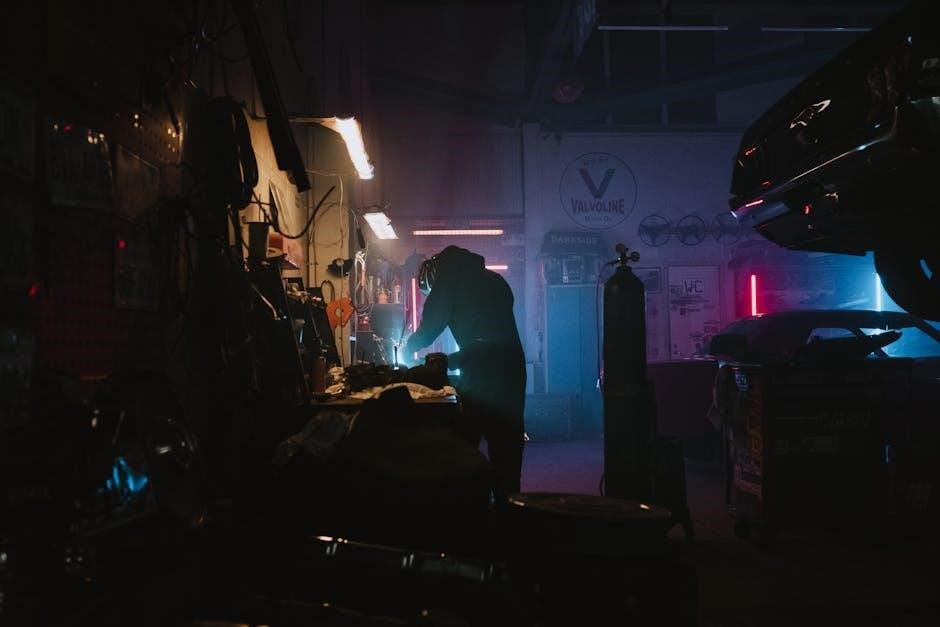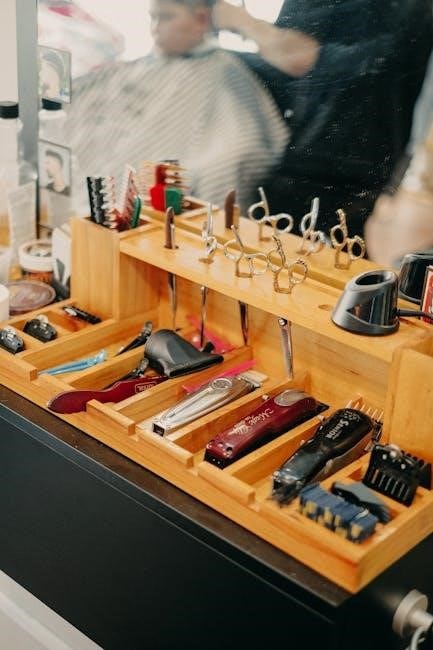manual or electric choke
A manual choke uses a cable-connected lever for air-fuel mixture control‚ common in older vehicles‚ while an electric choke automatically adjusts using an electric heating element.
1.1 Brief Explanation of the Choke Function
The choke is a critical component in carbureted engines‚ responsible for enriching the air-fuel mixture during cold starts. By restricting airflow‚ it increases fuel concentration‚ aiding engine startup. Manual chokes require driver input via a dashboard lever‚ while electric chokes automatically adjust using an electric heating element. Both types aim to ensure proper combustion when the engine is cold‚ improving starting reliability and performance.
1.2 Overview of Electric Choke Mechanism
The electric choke operates using an electric heating element controlled by a thermostat or coolant temperature sensor. When the engine is cold‚ the sensor activates the choke‚ enriching the air-fuel mixture. As the engine warms up‚ the choke gradually opens‚ returning to a leaner mixture. This automatic adjustment eliminates the need for manual intervention‚ providing seamless operation across varying temperatures and reducing driver effort for a smoother startup experience.
1.3 Overview of Manual Choke Mechanism
The manual choke mechanism relies on a cable-connected lever located on the dashboard. When the engine is cold‚ the driver pulls the choke knob to enrich the air-fuel mixture‚ enabling easier starting. As the engine warms up‚ the driver must manually adjust the choke to open it gradually. This system‚ typically found in older vehicles‚ offers simplicity and cost-effectiveness. It requires driver interaction but provides direct control over the engine’s operation during startup and warm-up phases.

Electric Choke Benefits
Electric chokes offer convenience and automatic operation‚ eliminating the need for manual adjustments. They provide ease of use in various weather conditions and adapt to engine temperature.
2.1 Ease of Use in Various Weather Conditions
Electric chokes simplify operation across diverse weather conditions‚ automatically adjusting without manual intervention. In cold climates‚ they ensure quick engine starts by precisely controlling airflow‚ enhancing reliability and driver comfort. Their adaptive nature eliminates the need for constant adjustments‚ making them ideal for unpredictable environments. This feature is particularly beneficial in regions with frequent temperature fluctuations‚ providing seamless performance regardless of external conditions. The automatic functionality reduces driver effort‚ ensuring a smooth experience in any weather scenario.
2.2 Adaptive Response to Engine Temperature
Electric chokes excel in adapting to engine temperature changes‚ ensuring optimal performance. They automatically adjust airflow based on temperature sensors‚ eliminating manual intervention. This adaptive response prevents over-fueling during cold starts and maintains smooth idling as the engine warms. The electric choke’s ability to dynamically respond to temperature fluctuations enhances fuel efficiency and reduces emissions. Its precision ensures consistent engine operation‚ making it highly efficient across varying temperature conditions while minimizing the risk of engine hesitation or stalling.

Manual Choke Operation
A manual choke requires driver interaction‚ typically via a dashboard lever‚ to adjust airflow during cold starts‚ providing direct control over the engine’s air-fuel mixture;
3.1 Full Control Over the Engine’s Air-Fuel Mixture
Manual chokes offer precise control‚ allowing drivers to manually adjust the air-fuel mixture during cold starts‚ enhancing engine performance and efficiency. This direct control ensures optimal combustion.
3.2 Cost-Effectiveness of Manual Chokes
Manual chokes are more affordable due to their simpler design and fewer components. They eliminate the need for electric heating elements‚ reducing both initial and maintenance costs. This makes them a budget-friendly option for drivers seeking reliable performance without added expenses. Additionally‚ their straightforward mechanism minimizes the risk of complex malfunctions‚ further lowering long-term maintenance requirements.

Performance Comparison
Manual chokes offer direct control over air-fuel mix‚ beneficial for specific conditions‚ while electric chokes provide automatic‚ adaptive adjustments‚ enhancing convenience and performance in varying environments.
4.1 Calibration Differences Between Manual and Electric Chokes
Manual chokes are typically calibrated for performance‚ often with larger jets and richer mixtures‚ while electric chokes are tuned for efficiency and emissions‚ offering leaner settings. This calibration difference impacts how each choke type performs under various driving conditions‚ with manual chokes usually favored in high-performance applications and electric chokes preferred for everyday driving due to their adaptability and smoother operation.
4.2 Impact of Choke Type on Engine Performance
Manual chokes provide drivers with precise control over the air-fuel mixture‚ enabling optimal performance in high-demand conditions. This customization is particularly beneficial for performance-oriented applications where quick adjustments are necessary. Conversely‚ electric chokes offer smooth‚ automatic operation‚ making them ideal for everyday driving. However‚ they may lack the precision needed for peak performance in specific scenarios. The choice between manual and electric chokes ultimately depends on whether control and performance or convenience are prioritized.
Installation and Adjustment
Manual chokes require mechanical adjustment via a cable-connected lever‚ while electric chokes are simpler to install‚ often needing only a power source connection for automatic operation.
5.1 Simplified Installation of Electric Chokes
Electric chokes are designed for straightforward installation‚ typically requiring only a power source connection. Their automatic operation eliminates the need for complex mechanical adjustments‚ making them user-friendly. Unlike manual chokes‚ which involve cable adjustments and lever setups‚ electric chokes rely on an electric heating element to function. This simplifies the process‚ reducing the time and effort needed for setup. The plug-and-play nature of electric chokes appeals to those seeking convenience and ease of use without compromising performance.
5.2 Adjustment Requirements for Manual Chokes
Manual chokes require precise adjustments during engine warm-up to ensure optimal performance. The driver must manually pull and adjust the choke lever to regulate the air-fuel mixture. This process involves monitoring engine response and fine-tuning the choke position to avoid over-rich or lean fuel delivery. Regular calibration may be necessary to maintain efficiency‚ especially in varying weather conditions. The hands-on nature of manual chokes demands a level of mechanical understanding and attention‚ which can be rewarding for experienced users but may deter others seeking simplicity.

User Experience
Manual chokes offer direct control‚ appealing to experienced users who value precision‚ while electric chokes provide ease and convenience‚ ideal for those seeking a hands-off experience.
6.1 Convenience of Electric Chokes
Electric chokes offer unmatched convenience‚ automatically adjusting the air-fuel mixture without driver input. They eliminate the need for manual adjustments‚ making cold starts faster and more effortless. With electric chokes‚ drivers can focus on driving‚ as the system ensures optimal engine performance in varying temperatures. This hands-off operation is particularly beneficial in cold climates‚ where manual chokes require frequent adjustments. The simplicity and ease of use make electric chokes a preferred choice for drivers seeking a hassle-free experience.
6.2 Driver Interaction with Manual Chokes
Manual chokes require direct driver interaction‚ typically through a dashboard-mounted lever or cable. This hands-on approach allows drivers to manually adjust the air-fuel mixture during cold starts‚ providing full control. While this offers precision‚ it demands attention and some mechanical understanding. Drivers must pull the choke lever gradually as the engine warms‚ ensuring proper idle and performance. This interaction can be engaging for enthusiasts but may feel cumbersome for those accustomed to automatic systems like electric chokes.

Reliability and Maintenance
Manual chokes are durable and require minimal maintenance‚ relying on simple mechanical components. Electric chokes‚ while reliable‚ can malfunction due to electrical or heating element issues over time.
7.1 Potential for Malfunction in Electric Chokes
Electric chokes can malfunction due to faulty heating elements or wiring issues. These components may fail over time‚ requiring replacement. Additionally‚ sensor failures can disrupt automatic operation‚ leading to improper air-fuel mixture during engine startup. Such malfunctions often result in poor engine performance or difficulties starting the engine‚ especially in cold conditions. Regular maintenance and inspections are essential to ensure reliability and prevent sudden failures. Electric chokes are generally more prone to such issues compared to manual systems.
7.2 Durability and Low Maintenance of Manual Chokes
Manual chokes are known for their simplicity and durability‚ requiring minimal maintenance. With fewer components‚ they are less prone to mechanical failure compared to electric chokes. The manual operation relies on a straightforward cable and lever system‚ which typically lasts longer without needing repairs. Drivers can easily adjust and maintain manual chokes‚ making them a cost-effective and reliable choice for engines. This durability ensures consistent performance without the risk of electrical malfunctions‚ appealing to those who prefer a hassle-free experience.

Legal and Safety Considerations
Manual and electric chokes must comply with emissions standards and safety regulations. Improper installation can lead to legal issues and safety hazards‚ requiring professional oversight.
8.1 Compliance with Emissions Standards
Both manual and electric chokes must meet emissions standards to ensure reduced pollution; Manual chokes rely on driver input‚ which can lead to inconsistent emissions if misused. Electric chokes‚ with their automatic operation‚ often provide more precise control‚ aligning better with emissions regulations. Non-compliance can result in legal penalties‚ making proper installation and adjustment critical. Authorities enforce strict guidelines‚ emphasizing the importance of choosing a choke system that adheres to environmental standards while maintaining performance efficiency.
8.2 Safety Precautions for Electric Choke Installation
Installing an electric choke requires careful attention to safety. Ensure the vehicle is on level ground and the engine is cold to prevent accidental starts. Always disconnect the battery before beginning work to avoid electrical shocks. Properly route wires away from heat sources like exhaust manifolds to prevent damage or fires. Follow the manufacturer’s instructions precisely‚ and avoid using damaged or worn components. Improper installation can lead to system malfunctions or safety hazards‚ emphasizing the need for professional assistance if unsure.

Environmental Factors
Environmental factors like temperature variations significantly impact choke performance. Electric chokes automatically adjust to cold conditions‚ while manual chokes may require more driver interaction in colder climates.
9.1 Cold Weather Performance
Cold weather significantly impacts engine performance‚ requiring precise air-fuel mixture control. Manual chokes allow drivers to manually adjust the choke‚ ensuring proper engine starting and operation in freezing temperatures. Electric chokes‚ equipped with heating elements‚ automatically adjust to cold conditions‚ providing consistent starts without manual intervention. However‚ malfunctions in electric chokes can hinder cold weather performance. Manual chokes offer reliability but demand driver expertise‚ making electric chokes more convenient in regions with frequent cold snaps.
9.2 Impact of Temperature on Choke Operation
Temperature fluctuations significantly influence the operation of both manual and electric chokes. Manual chokes require precise driver input to adjust the air-fuel mixture during cold starts. Electric chokes‚ with their heating elements‚ automatically adapt to temperature changes‚ ensuring consistent engine performance. However‚ extreme cold can cause electric chokes to malfunction‚ while manual chokes remain reliable if calibrated correctly. Proper maintenance and calibration are essential for both types to ensure optimal functionality across varying temperature conditions.
